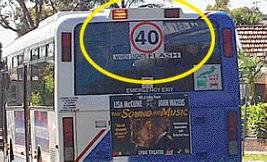Bus lanes are designed to keep public transport moving effectively, and that reduces overall congestion. However, if you are turning into a side street or driveway you may drive in a bus lane for up to 100m until you make the turn. Carrying passengers does not entitle you to use the bus lane.
Gentle inputs to the throttle and steering will minimise your chances of losing control.
The traffic controller will let you know when it's safe to pass through the road works. There might be vehicles coming the other way, or workers or machinery blocking the lane.
For other vehicles to be able to exit safely, leave a gap of at least one metre. It also reduces the risk of damage to your vehicle.

Pedestrians may have disembarked and might try to cross. Observing the 40km/h speed limit gives you more chance to stop if you need to.
This area is reserved exclusively for taxis.
20 metres gives enough room for other vehicles to manoeuvre around a parked vehicle.
Advertisement
Wait at the intersection until the ambulance has passed through. Ensure there are no other emergency vehicles following it.
Unless you are overtaking another vehicle you should drive in the left hand lane to ensure the best traffic flow.
Helping injured people is the first priority.
The median strip is only to be used to allow vehicles to safely turn into a side road without impeding the flow of traffic, or to enter traffic flow safely from a side road.
Double parking obstructs the road way and causes a hazard for other road users.
If you have a bike rack or towbar that covers the licence plate you must make other arrangements to display the plates clearly.
If there are angle park markings, that is how you should park.
Advertisement
Clearways are designed to keep traffic moving in busier times, therefore parking during clearway hours would obstruct traffic.
Farm animals may be present - possibly around a blind corner - so it is safest to slow down and be prepared to stop.
Continually scan all directions from the vehicle so that you can anticipate situations that may occur where you need to react.
They are smaller and less visible, particularly as you scan up the road, and they do not have the protection that drivers in cars, vans and trucks have.
Please select 2 correct answers
Leaving a gap of at least 60 metres allows other vehicles to pull in, if required, after they have overtaken you. Note that this rule is only for roads without streetlights.
Your doctor is not responsible for notifying the Roads and Maritime and you do not need to hand your licence in. Contact Roads and Maritime first.
Road works signs are there to warn you that the road conditions may be dangerous at any time (e.g. slippery or potentially damaging to your vehicle at higher speeds).
Advertisement
You are in control and other drivers' impatience should not influence your decisions to act safely.